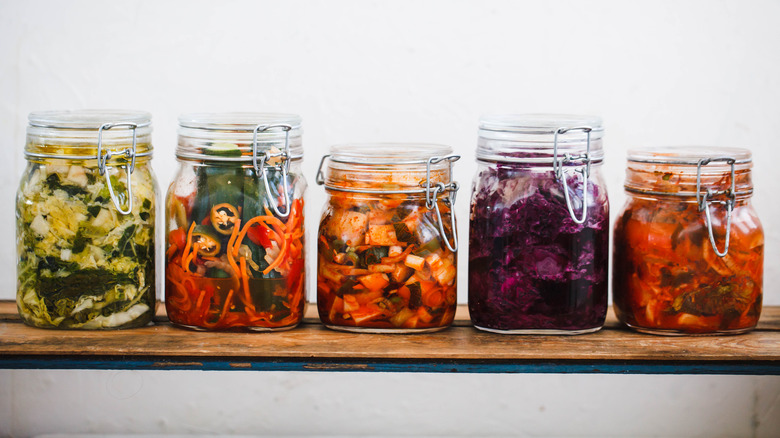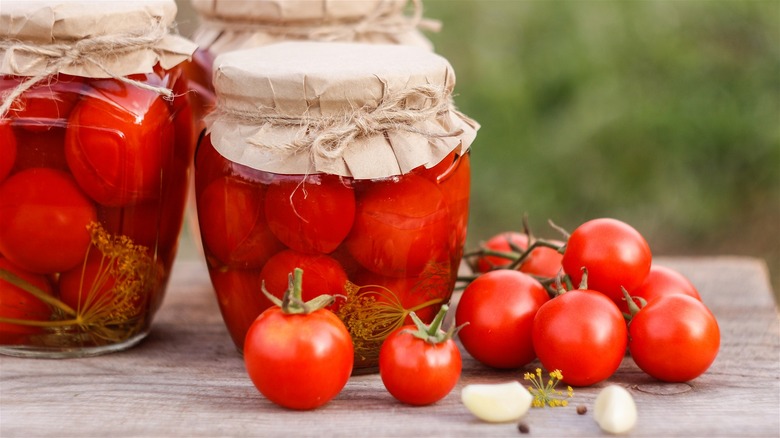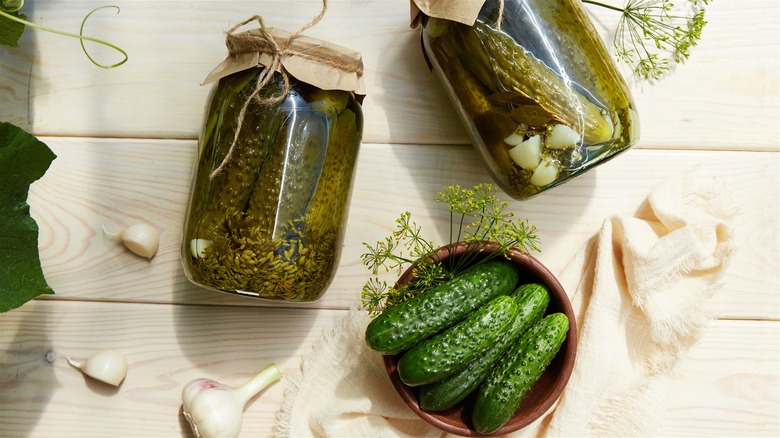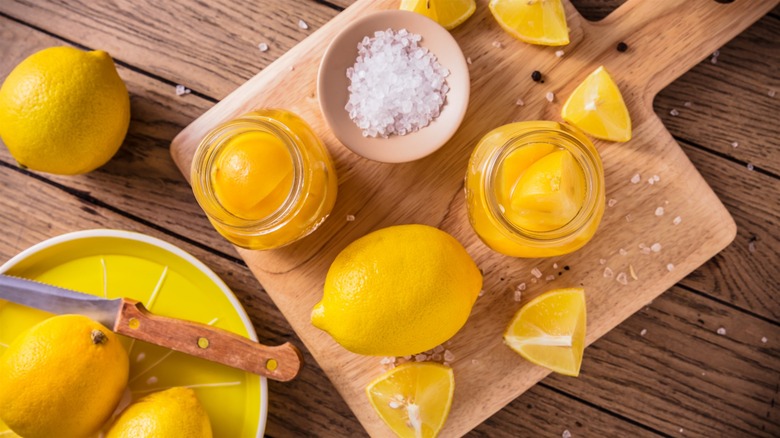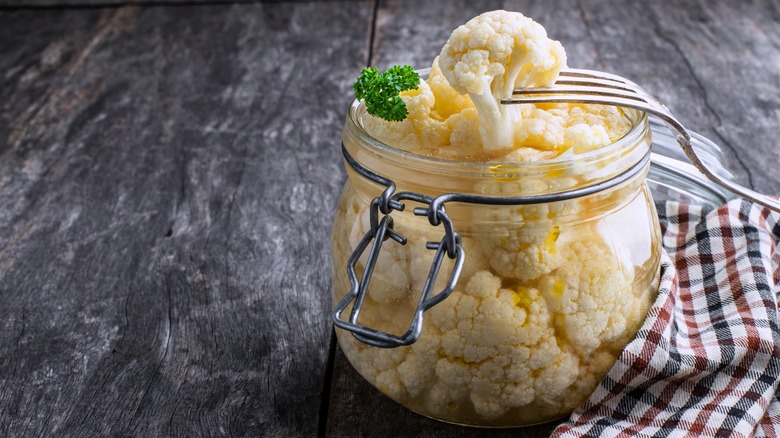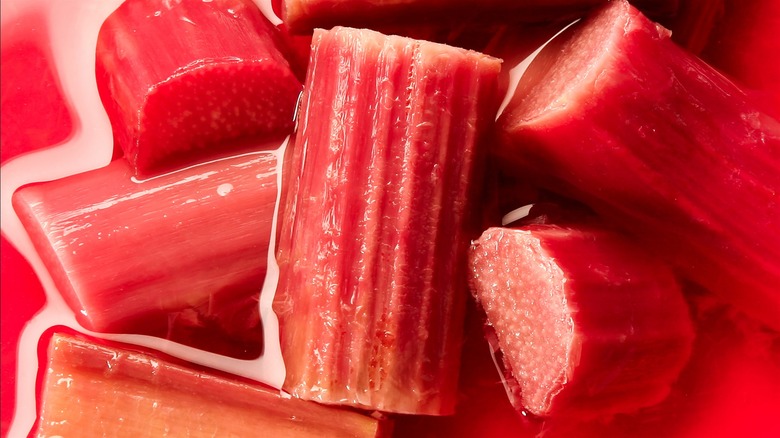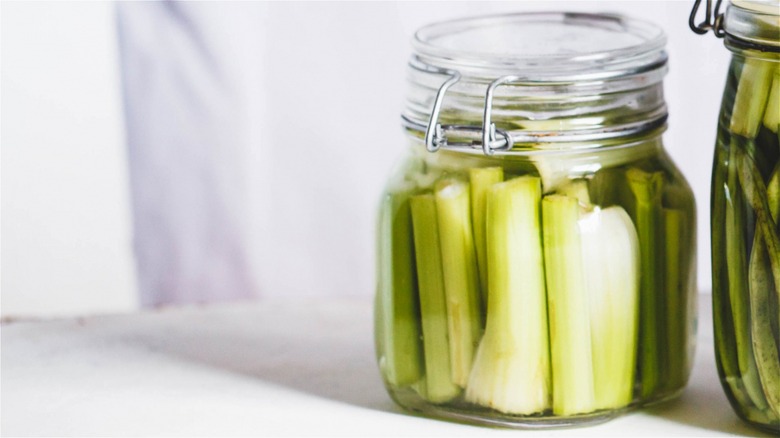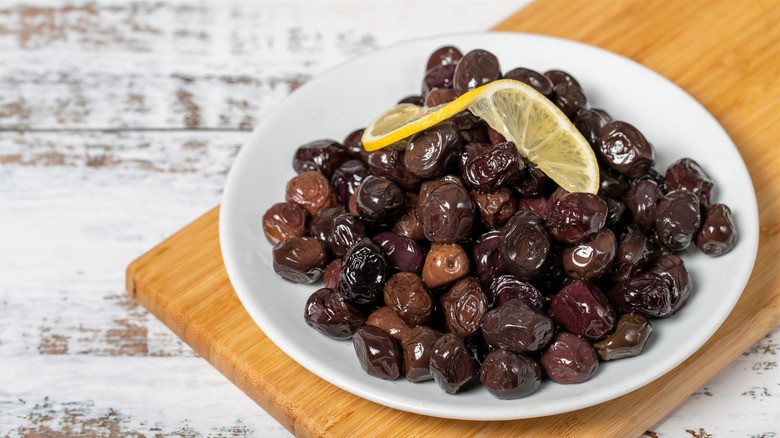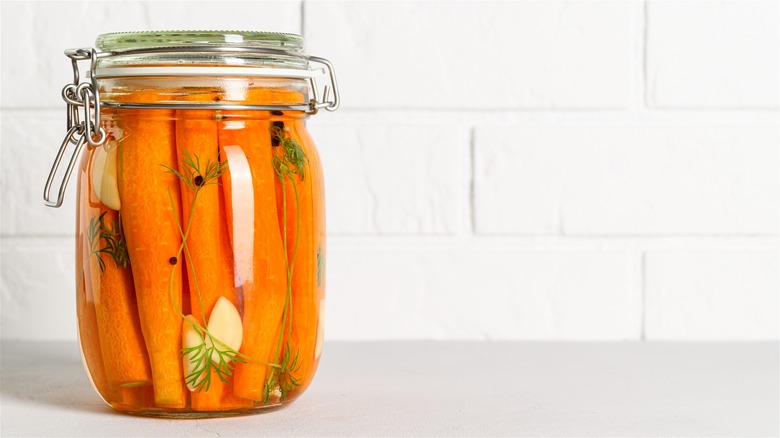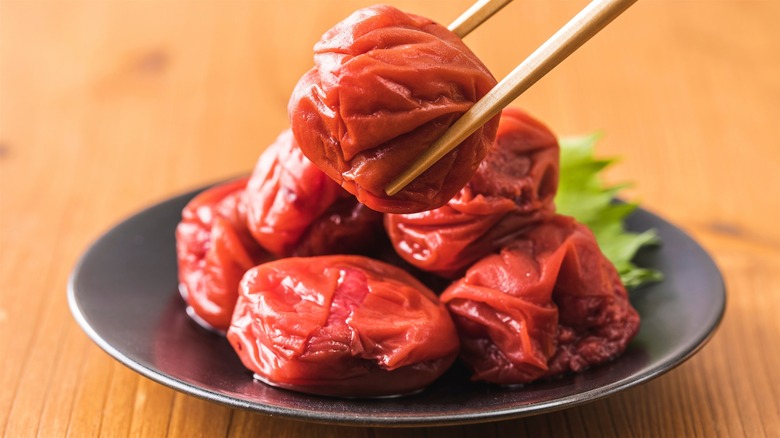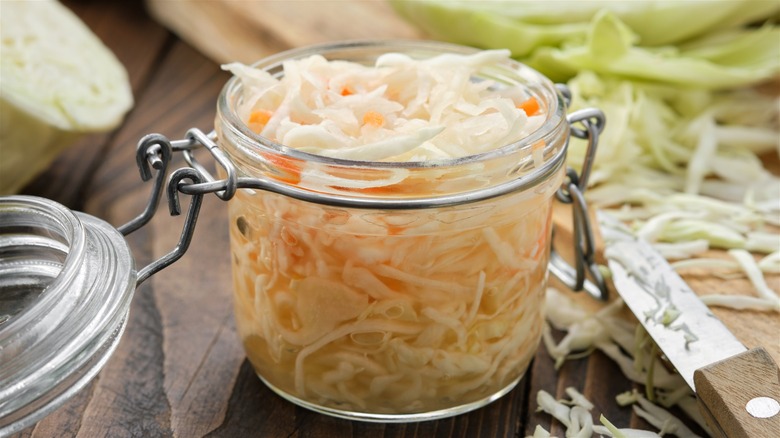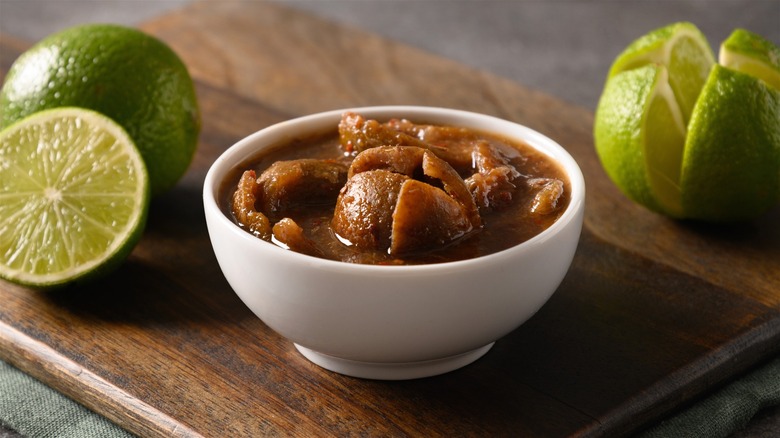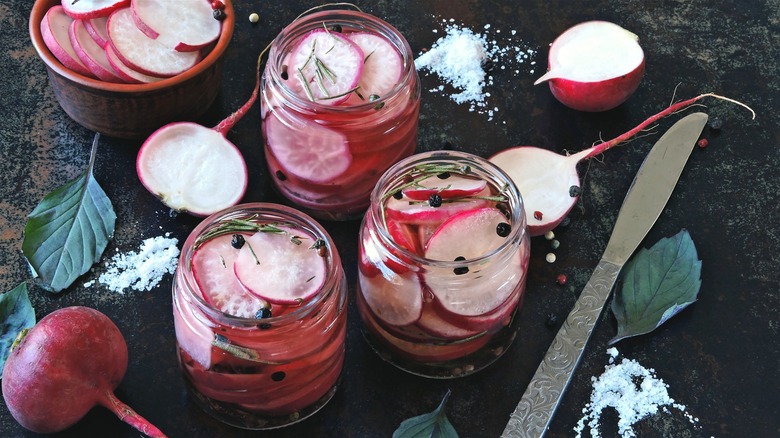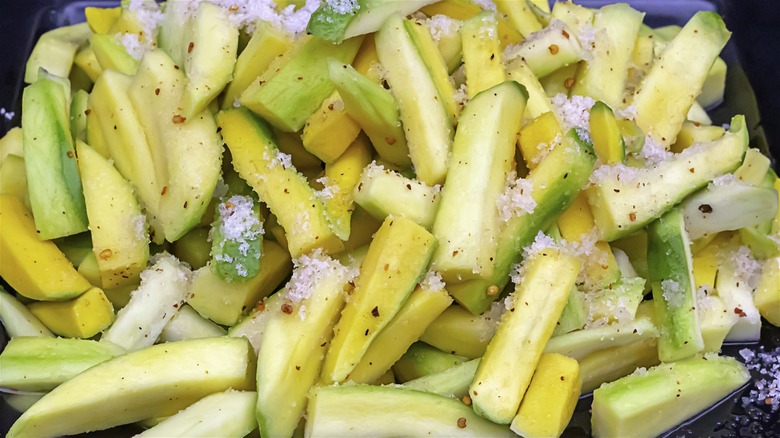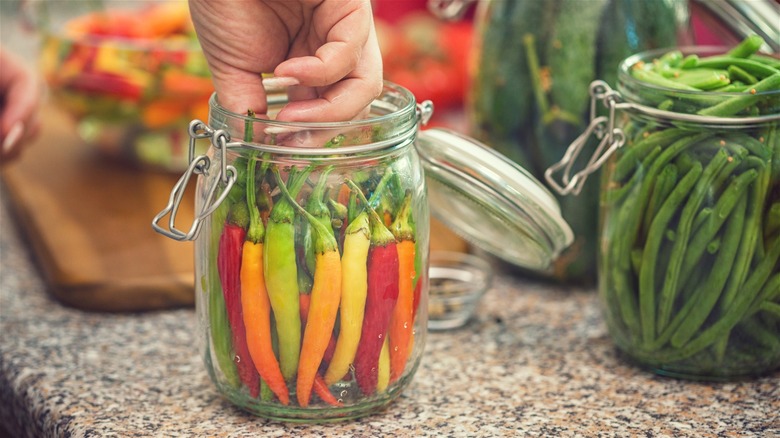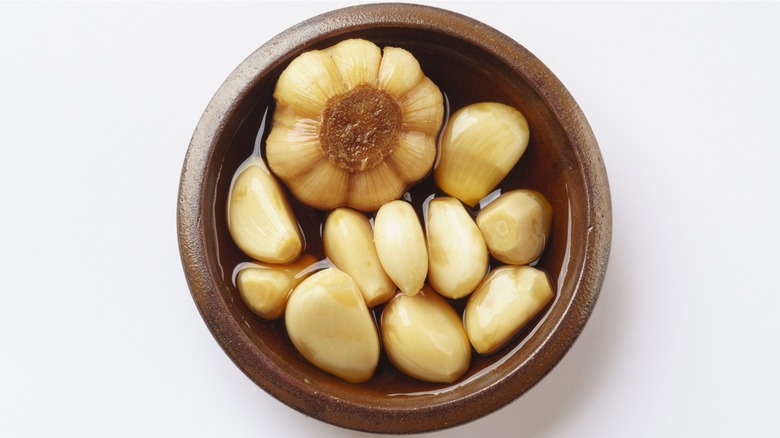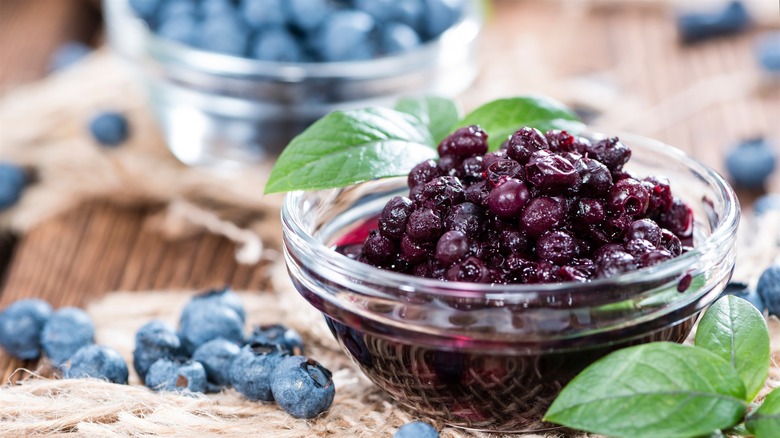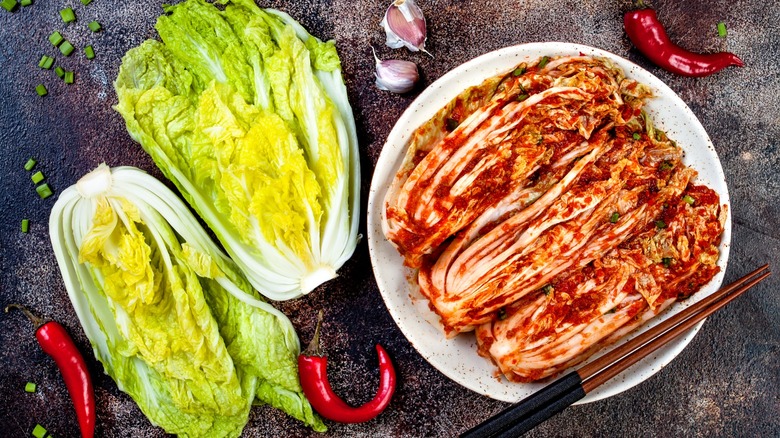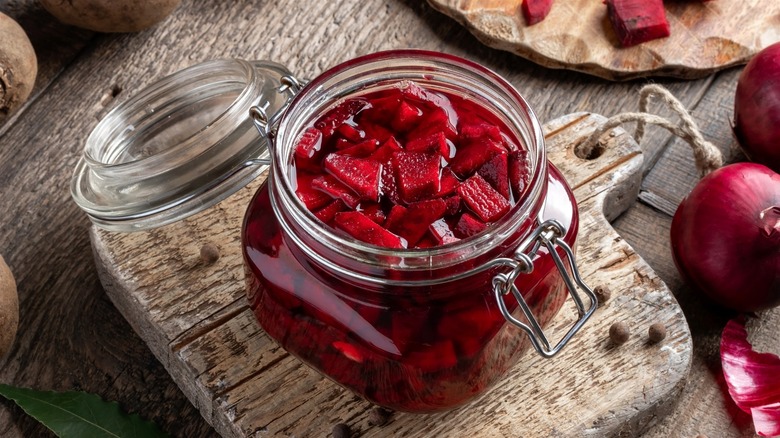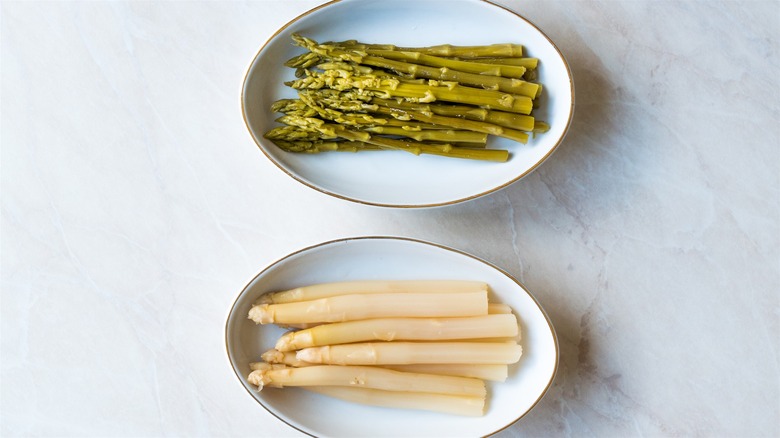19 Best Fruits And Vegetables To Lacto-Ferment
Lacto-fermentation is a precise art, yet it's still beginner- and budget-friendly. It doesn't require much more than produce (including vegetable scraps), salt, and time. While all bacteria growth is brought to a halt during pickling and canning (processes which employ vinegar and heat to annihilate any microbe development), lacto-fermentation relies on a delicately balanced salt brine to kill off unwanted microorganisms while helping beneficial bacteria to thrive and produce lactic acid, which preserves food. The result? Fruits and veggies with complex flavors, and often a satisfying crunch.
It's interesting to see how a food-preservation technique that was once the only way to survive in times of scarcity has become a global health-food trend in the last decade, as world-famous restaurants like Noma use fermented ingredients in many dishes. While many of us may no longer need to ferment produce, with much of it freshly available throughout the year, there is a primal excitement to be found in watching our food come alive — again — with the help of wild yeast and bacteria. So get out your kitchen scale and online brine calculator, and indulge in the edible alchemy of amba, kimchi, giardiniera, umeboshi, and nimbu ka achaar, to name a few fermented specialties from around the globe.
Tomatoes
Fermentation is known to up the umami of certain foods, and what better plant to work its magic on than the already umami-packed tomatoes? This beginner-friendly ferment requires little more than the plump red fruit and a 2%-4% salt water brine — however, you can add any classic pickling spices, if desired.
Homegrown tomatoes work best, as you won't need more than a quick rinse to get them ready for the fermentation process. Smaller cherry tomatoes, punctured with a toothpick, retain their shape and bite, creating perfect orbs of flavor, while the larger, robust tomatoes are destined for dissection, ready to contribute their tangy juice to other culinary creations. If working with larger tomatoes, you could even strain the solids from the fermented liquid and turn it into a seriously umami-packed paste, while the juice can be added to cocktails, salad dressings, or soups.
Cucumbers
While raw cucumbers are refreshing gems on their own, it seems as if they were destined to end up in all sorts of preserves, from dill pickles to cucumber kimchi. Humans have grown so fond of this particular vegetable's zingy crunch over the last 8,000 years that unique pickling varieties were eventually cultivated: perfectly sized to fit neatly in jars, their skin thick enough to retain the crunch but thin enough to let the flavors penetrate their every fiber. Whichever variety you choose, however, you must remove the cucumber's blossom part when making pickles, or you risk them losing their crunch.
When fermenting cucumbers, you can't go wrong with packing them tightly into a jar, covering them with a 5% salt brine, and leaving them in a dark place for a few weeks — unless you're making Hungarian pickles, a process that encourages bacteria to bask in the sunshine (and, oddly, snack on bread).
Lemons
If you like the way preserved lemons provide an umami flavor boost in everyday cooking, make fermenting lemons a priority. The preserved lemons recipe is easy: Whole lemons (scrubbed to remove wax if store-bought), with their tops sliced off and their bodies quartered, are submerged in a 3% salt brine and left for a couple of weeks. The result tones down the sharp acidity of the fruit while increasing the salinity and developing a complex flavor.
But before you get carried away, there are a few things to consider before using preserved lemons. The boldly flavored peel should be chopped finely and kept separate from the tender flesh. It's best used sparingly in recipes where it would be cooked further, like tagines and stews. The pulp can be strained or mashed into dishes. Finally, the juicy brine can be added to marinades and drinks, such as chanh muoi, a Vietnamese lemonade.
Cauliflower
The subtly sweet and fleshy cauliflower makes an excellent vegan steak and a favorable base for creamy dairy-free sauces, but its natural crunch is often overlooked. After all, who wants to eat a bland raw cauliflower floret? This is where the magic of lacto-fermentation comes in, preserving the firm, satisfying bite of fresh cauliflower while infusing it with various flavors — and colors!
While you could follow the basic recipe of submerging raw florets in 2% brine, why not make it more interesting? You may have heard of giardiniera, a mixed-vegetable pickle blend typically made with vinegar — but if you're not in a rush, lacto-fermenting the mix for a few weeks will produce a more exciting flavor. Additionally, you can always ferment it with spices such as curry and turmeric for color, add some heat with fresh or powdered chili peppers, or give it a Nordic twist with dill and caraway.
Rhubarb
Rhubarb sits in the twilight zone of the culinary world — a vegetable moonlighting as a fruit, most commonly found in jams and pies, its brightly colored astringent stalks offset by the sugar in those dishes. But subject its tartness to lacto-fermentation, and you'll witness its tang mellowing, developing into a complex, zesty character. Adding warming spices such as cinnamon, nutmeg, cardamom, or some fresh orange and ginger will take this preserve to the next level. It should be ready in under a week, and will keep in the fridge for a couple of months.
Versatile as it is vibrant, fermented rhubarb plays well with others — transforming the flavor of Great Britain's fool desserts, elevating a simple yogurt, and even jazzing up a cocktail. For a more savory take, pair it with creamy cheese on toast or toss it into a salad for an unexpected pickle perk.
Celery
The wretched "negative calorie snack" beloved by toxic diet culture, celery in its raw form isn't much to write home about — at best, a neutral vessel for dips; at worst, a bitter, stringy disappointment (that does, in fact, contain calories). But lacto-fermentation can make this humble veggie pop. Submerge the crunchy stalks in a 2%-2.5% brine solution, and give it a week or four to work its magic. You'll end up with a snack with more crunch and character than you ever imagined. And it doesn't stop there.
For a refreshing twist, add mint leaves into the mix or chop the stalks into a fermented giardiniera. Got some black peppercorns, fennel seeds, and parsley? Add those in to create celery kvass — use the brine as a base for a Bloody Mary cocktail and garnish the glass with a fermented celery stalk to complete the experience.
Olives
Every olive you've ever tasted (unless you picked it right off the tree and bit into it) has undergone some briny, salty transformation, be it curing, pickling, or fermenting. Table olives rank among the world's most prevalent foods — and one of humankind's earliest fermented specialties. The salt brine typically used for black olive fermentation is inspired by seawater, an ancient natural brine. However, the proportion of salt to water can increase to 10% for green olives. All of this is necessary to remove the inherent bitterness of olives caused by oleuropein.
Unique curing processes are required for all popular types of olives, but it's possible to experiment with black and green olive fermentation at home. The only drawback? A truly long waiting period that can last from a couple of months to a full year. As the bitterness wanes, a nutty, nuanced flavor emerges — the hallmark of a well-fermented olive.
Carrots
When you're looking for something new to ferment, you can't go wrong with a sturdy, crunchy vegetable. Carrots are a perfect example: they retain the satisfying bite while developing a next-level flavor, especially when paired with orange or ginger.
The process is straightforward: clean, scrub, and chop the carrots into jar-sized sticks, then use your most recent memory of rush hour on the subway as inspiration when you pack them into the jar to ensure full brine immersion. This is nicely paired up with fermented celery and cucumbers for a tangy twist on crudités. Grate them before fermenting, and you'll get a treat worth putting on your tofu banh mi; ribbon them first, and they'll make a beautiful bagel or salad topping. You can also stuff them into homemade vegan sushi, or use them as a last-minute addition to miso soup.
Plums
When it comes to plum fermentation, you can choose your own adventure: the patience-testing umeboshi, adored in Asia for its mouth-puckering sourness and deep umami, or the quicker, sweeter ride of lacto-fermented plums.
If you're into really sour foods, grab fresh ume plums, pair them with shiso for that signature blush, and wait a moon cycle to achieve that revered tang. Sun-drying the pickled umeboshi is crucial for its transformation. If ume is hard to find or time is of the essence, mix ripe plums of choice in a vacuum-sealed bag with about 2% of their weight in salt, and within a week, you'll have a sweet-savory treat to top anything from rice to desserts. Whichever route you take, ensure your plums are ripe — hardness is the enemy of fermentation in this case. And if you want to kickstart the process, a splash of brine from a previous ferment works wonders.
Cabbage
No guide to lacto-fermentation would be complete without cabbage — at this point, it's practically synonymous with the process. While German sauerkraut might be the most famous example, there are plenty of variations in other cultures, with different cuts, ingredients, and preparation techniques. But it always starts with a fresh, ripe, firm head of cabbage that has accumulated enough sugar for the lactic bacteria to feast on, along with some salt and time.
While their makeup is humble, there's no shortage of creative uses for cabbage ferments. There are many ways to use sauerkraut in your favorite dishes, including pairing it with baked potatoes, mixing it into chickpea salad, and using it to punch up guacamole. And don't even get us started on the liquid gold that is leftover sauerkraut juice — drink it as a gut-health-boosting shot or mix it into marinades, vinaigrettes, and soups.
Limes
Believed to have originated in India, so-called lime pickles (which aren't really pickles, as they're lacto-fermented first) eventually reached England and then 19th century America, where they graced the pages of cookbooks (and even "Little Women"). Nimbu ka achaar, an Indian citrus ferment with limes, is often made with oil as an added preservative, while its Western counterparts bathe in their own juices or a vinegar solution (added once they've fermented). Either way, you start with salted limes and add flavorings later on.
Both varieties prefer to bask in the sun, not be hidden in dark cupboards, letting the heat coax out the full potential of added spices. Treat these "pickles" like culinary salt — a dollop can transform plain rice into an aromatic affair. For the salt-preserved limes, shun the salt-heavy flesh in favor of the rind and pith. Add them raw to dishes for a subtle, salty, and citrusy accent, and watch the magic of fermentation unfold.
Radishes
Often sidelined for their intense bite, radishes of all kinds find redemption under the lactic acid bacteria spell. They're lower in sugar content than other fermentation favorites, such as carrots and cabbages, so you'll often see them paired in recipes from different types of kimchi to Vietnamese đồ chua. Whether it's the refreshing bite of fermented daikon before a hearty meal or the subtle zest of dongchimi (Korean radish water kimchi) brine as a soup base, the transformation is real.
And don't forget about the plain old pink radishes — let them dive head-first into a 5% salt brine, and in a week or so, you'll see a different side to them. With pungency giving way to pleasant tanginess and the flesh blushing a delicate pink, they are ready to add a stunning visual accent to salads and open-faced sandwiches. Give radishes a second chance, and their glow up might surprise you.
Mango
While you could lacto-ferment ripe mango chunks in a vacuum-sealed bag and call it a day, you can always take it to the next level by concocting amba, the Middle Eastern condiment made with pickled mango. While its origins are complicated, amba has evolved into more than a fruit preserve — it's also a way to preserve culinary traditions.
Should you attempt to make it yourself, opt for using unripe mangoes unless you wish to veer your creation toward boozy territory. Allocate at least 10 days for the mangoes to stew in the salt brine, then drain and blend them with a rich golden paste of oil-bloomed spices — turmeric, fenugreek, garlic, and more. Once jarred, this bold condiment stands ready to elevate your grilled foods, dips, and other dishes with its complex, savory flavor.
Peppers
No matter how you plan to use your preserved hot peppers, always start with plump, firm fruit, steering clear of the ultra-fiery ones above half a million Scoville units, as spicier pepper compounds may slow the fermentation process. Aim for a 3.5% brine, though keeping it to 2.5% can work if you snip the stems beforehand. (Bizarrely enough, those pepper stems can be mixed with milk to create DIY yogurt.) As you gear up, don gloves; these capsaicin-laden beauties sting.
After a few weeks, they'll mellow out, tart and ready. Pulverize them into hot sauces once they've fermented — they'll have a smoother acidity than vinegar-based sauces. Alternatively, for homemade sriracha, blend everything before fermenting and add vinegar as the final touch. Trust your senses to gauge when your fermented hot sauce is safe to eat — it should have no foul odors, just a clean, tangy scent and taste to signal success.
Garlic
Enter the world of garlic fermentation, and you'll unearth flavors that make the raw form seem almost pedestrian. Patience is key — allow the cloves to ferment for at least a month, though two months can work wonders, coaxing out an amplified sweetness and softening the bite. Alternatively, roast the garlic first, then use cabbage or the brine from another lacto-ferment to jumpstart the process.
Usually, discoloration is a cause for great concern, as it often indicates irreversible spoilage. However, if your fermented garlic turns blue, don't rush it into the compost bin — it's just the anthocyanin reacting to the acid. The otherwise golden-brown result can double the impact of fresh garlic in any dish, bringing subtle depth to roasted veggies or elevating a simple pesto. Mash it into butter for a decadent spread, slice it onto a sandwich for a tangy twist, or let it transform your guacamole.
Blueberries
Whether green or ripe, blueberries are always ready to take in the transformative power of fermentation. Naturally packed with antioxidants, they excel in both the flavor and nutritional departments. Ferment the plump dark berries at a cozy 82 degrees Fahrenheit for about five days, and they'll emerge, still shapely, with a tangy kick that belies their sweet origins. Curiously, you can capture this magic by draining and freezing them to enjoy the exquisite flavor year-round.
If you're feeling adventurous, consider experimenting with unripe blueberries. Think of them as unconventional counterparts of capers, ready to dazzle on a cheese board or punch up a salad. Alternatively, ferment them umeboshi-style — with more salt, more time, some shiso leaves, and a final touch of sun-drying. Whether strewn over a parfait or melting into a mostarda, these transformed berries are bound to become your go-to ferment.
Napa cabbage
Just as regular white cabbage is the world-famous base for sauerkraut, Napa cabbage is the star ingredient in what we've come to know as kimchi (specifically, tongbaechu kimchi; different types of kimchi often utilize varied vegetables as a base). Traditionally, raw heads of cabbage are quartered, salted (or soaked in a 10%-15% salt solution), rinsed thoroughly, then mixed with seasonings, which are spread between the still-attached leaves. However, there's a beginner-friendly way to prepare homemade classic mak kimchi, which involves chopping the cabbage heads first to simplify the whole process.
Napa cabbage's fermentation potential certainly isn't limited to kimchi. For one, you can turn it into sauerkraut — adding fresh turmeric into the mix will brighten the kraut's color. Alternatively, try hakusai no tsukemono, a simple Japanese lacto-ferment seasoned with garlic, yuzu, and chili peppers.
Beets
The naturally high sugar content in beets is a double-edged sword — on one hand, it can easily produce alcohol during fermentation, which makes working with beets a bit more high-maintenance. However, the sugar also contributes to the unique flavor profile that retains some sweetness, contrasted and highlighted by salinity and developed zest.
To start, just give the beets a good rinse and a thorough scrub (no need to peel them unless you want to), and then decide on the cut, which will affect the flavor and further applications. Slice them into sticks for a mildly sour, crunchy treat, or go mandoline-thin for a bolder tang. Want to amp up the flavor? Throw in alliums, herbs, or a medley of vegetables like carrots and radishes. For a deeper dive, transform them into a zesty beet kvass — a health drink, a vinegar stand-in, and the soul of Polish barszcz soup.
Asparagus
While white asparagus can be available most of the year, its late-spring peak season is relatively short, and you might want to preserve its beautiful stalks via lacto-fermentation. Start by snipping them to fit snugly in a jar, but do so with care to avoid bruising. They do well in a 3%-4% salt solution, paired with other flavors such as garlic, mustard seed, dill, horseradish, tarragon, and citrus fruit (a slice or two of orange inserted on top of the spears can help keep them submerged). The same method can be applied to green asparagus.
If you peel white asparagus stalks first, the fermentation time might decrease from a week to a couple of days. Store your fermented asparagus in the cool confines of your fridge, and these thick, crunchy spears will keep for months, always ready as a delightful addition to salads, a gourmet touch to cheese platters, or a probiotic-rich snack straight from the jar.
Static Media owns and operates Tasting Table and Mashed.
